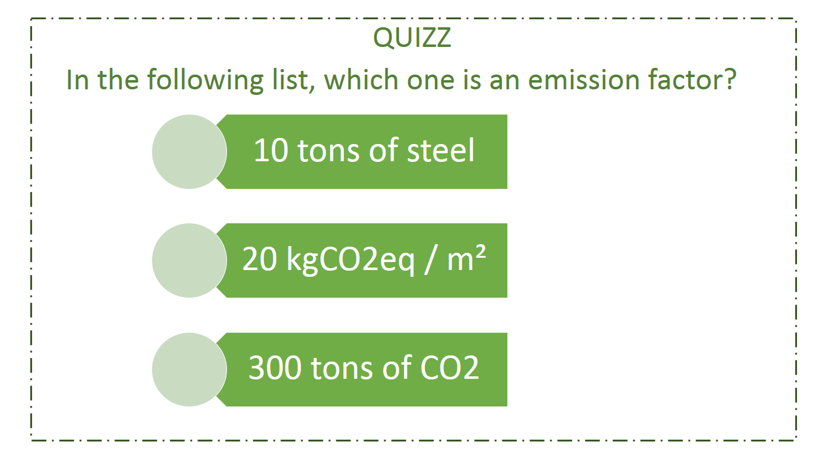- Accueil
- Base de données
- La base de données Clim'Foot
- Qu est ce qu un facteur d émission ?
- What is an emission factor?
What is an emission factor?
The release of GHG into the atmosphere depends mainly on the activity and the product. In order to estimate GHG emissions per unit of available activity, we need to use a factor called emission factor (EF).
For example: how many kg of GHG are emitted by 1 kWh of natural gas ?
Definition
An emission factor is a coefficient which allows to convert activity data into GHG emissions. It is the average emission rate of a given source, relative to units of activity or process/processes.[1]
For example: the natural gas emits 0.244 kg CO2eq / kWh ICV (European mean) with 5% uncertainty.
Thus, the emission factor is the sum of emissions of CO2eq of the human activity described as mass unit of CO2eq / reference flows. For example: the EF for the natural gas is the sum of the combustion (0.205 kg CO2eq / kWh ICV) and the upstream (i.e. the production and transport of the gas) (0.0389 kg CO2eq / kWh ICV).
What is CO2eq ?
A human activity emits different kind of greenhouse gas (GHG) (see below). Their Global Warming Potential (GWP), a physical characteristic of a GHG, represents their impact on the greenhouse effect, and allows to convert 1 kg of GHG into X kg of CO2 equivalent, noted CO2eq. Thus, emissions of different gases can be compared.
What is an EF?
Constitution of an EF
To constitute an emission factor, we need to produce a dataset which describes and quantifies the activity generating GHG.
The Clim’Foot database includes the greenhouse gases covered by the Kyoto Protocol.
Kyoto Protocol GHG
Each GHG emission is converted in CO2eq and then summed. The conversion is made by multiplying gas quantity (kg GHG) with their GWP (kg CO2eq / kg GHG) in order to express impacts in CO2eq. Nitrogen trifluoride (NF3) has been recently added.
Uncertainty
In the countries where data are not specific, organisations are reluctant to apply international values since the accuracy of the results is not guaranteed (due to difference between the localisations). Indeed, the calculation of carbon footprints is then based on generic data that can be totally different to the real situation, and thus have a high uncertainty. This has major impact on the credibility of any results coming from any calculation method.
When developing an emission factor, the issue of uncertainty and its evaluation arises. Moreover, different sources of uncertainty can be identified:
- Parameter uncertainty: a measure of how close the data used to calculate emissions are to the actual data and real emissions. For example: GWP values are associated with an uncertainty of ± 35% for the 90% confidence interval. The estimated uncertainty of emissions from individual sources (e.g. power plants, motor vehicles, dairy cattle) is either a function of instrument characteristics, calibration and sampling frequency of direct measurements, or (more often) a combination of the uncertainties in the emission factors for typical sources and the corresponding activity data.
- Model uncertainty: limitations in the ability of the modelling approach used to reflect the real world;
- Scenario uncertainty: methodological choices allocation, product use assumption, EoL assumptions.
To see the answer of the quizz, just move the mouse over the picture !
See the next page "What are the databases produced in the Clim'Foot project". Or return to the menu.

